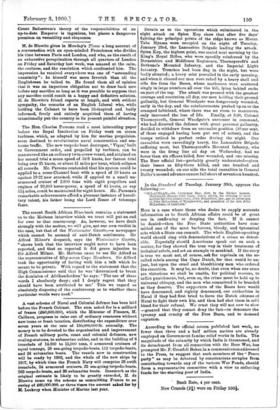Details as to the operations which culminated in the night
attack on Spion Kop show that after five days' fighting the principal points of the ridge known as Mount Taba Myama were occupied on the night of Tuesday, January 23rd, the Lancashire Brigade leading the attack. Spion Kop, the highest point, was scaled next morning by the King's Royal Rifles, who were speedily reinforced by the Dorsetshire and Middlesex Regiments, Thorneycroft's and Bethune's Mounted Infantry, and the Imperial Light Infantry. Trenches had been dug in the night, but were badly situated ; a heavy mist prevailed in the early morning, and when it cleared our men were raked by a heavy shell and rifle fire from the Boers, whose marksmen were scattered singly in large numbers all over the hill, lying behind rocks on part of the top. The attack was pressed with the greatest courage and resolution all day, our men holding their ground gallantly, but General Woodgate was dangerously wounded, early in the day, and the reinforcements pushed up on to the cramped tableland, where there was no room to mancenvre, only increased the loss of life. Finally, at 8.30, Colonel Thorneycroft, General Woodgate's successor in command, who had directed the defence with great personal gallantry, decided to withdraw from an untenable position (40 per cent. of those engaged having been put out of action), and the troops retired in perfect order during the night. Our casualties were exceedingly heavy, the Lancashire Brigade suffering most, but Thorneycroft's Mounted Infantry, who were in the firing line all day on Wednesday, had no fewer than six officers killed, four wounded, and one missing. The Boer official list—probably greatly understated—gives their losses as fifty-three killed, and one hundred and twenty wounded; on our side the total casualties in General B tiller's second advance cannot fall short of seventeen hundred.






































 Previous page
Previous page